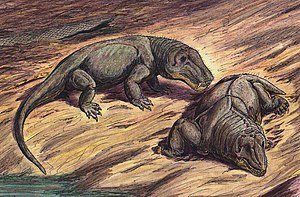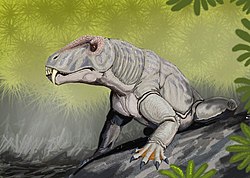Doliosauriscus
| Doliosauriscus | ||||||||||||
|---|---|---|---|---|---|---|---|---|---|---|---|---|

Live reconstruction of Doliosauriscus |
||||||||||||
| Temporal occurrence | ||||||||||||
| Middle Permian | ||||||||||||
| 265.8 to 260.4 million years | ||||||||||||
| Locations | ||||||||||||
|
||||||||||||
| Systematics | ||||||||||||
|
||||||||||||
| Scientific name | ||||||||||||
| Doliosauriscus | ||||||||||||
| Kuhn , 1961 | ||||||||||||
| species | ||||||||||||
|
||||||||||||
Doliosauriscus is an extinct genus of carnivorous synapsids ("mammal-like reptiles") from the late Middle Permian ( Capitanium ) of Russia . The genus was first described in 1958 by the Russian paleontologist Juri Alexandrowitsch Orlow as Doliosaurus , but the genus name was changed by Kuhn tothe form it is todaydue to homonymy . The type species is D. yanshinovi .
Fossils of the type species D. yanshinovi come from the Russian region of Perm, remnants of a second species, D. adamanteus, formerly assigned to Doliosauriscus , from the Orenburg oblast ( small uranium ), which was on the equator during the Permian period. Doliosauriscus is very similar to the South African genus Anteosaurus and Titanophoneus, which is also found in Russia .
anatomy
Doliosauriscus yanshinovi
With a length of three to four meters, Doliosauriscus was, together with Titanophoneus, the top predator in its ecosystem. D. yanshinovi is handed down with a very well preserved skull and skeleton. The skull was fifty-three centimeters long and tall and straight; the eye sockets and the opening for the parietal eye were not very large. The dorsal cranial bones were thickened by rough outgrowths, especially the crown area.
The basic structure of the skull was very similar to that of Titanophoneus and Syodon , but the skull was probably a little lower and wider than that of Titanophoneus . The postorbital was very large and formed a sturdy splint between the eye sockets and cranial windows for the attachment of the jaw muscles . The relatively large snout housed a set of teeth that was slightly reminiscent of that of mammals, but still had many reptile-like features. So had doliosauriscus already three types of teeth, especially the saber-tooth-like fangs stood out. The sharp front rows of teeth and the rear rows of teeth, which are also pointed, differ from one another in length, but are not yet specialized.
Doliosauriscus adamanteus
This species is preserved with a skull and a lower jaw . However, there is no certainty that the two parts belong together. Both parts come from the area of small uranium . The skull reached a length of 55 centimeters. Olson suggested in 1962 that the type specimen of D. adamanteus differs sufficiently from D. yanshinovi to place it in its own genus, which in turn is closer to Titanophoneus . Accordingly, this species has been assigned to the genus Titanophoneus since 1997 .
Individual evidence
- ↑ Orlov, JA, 1958. Les Dinocephales rapaces de la faune d'Ischeevo: Trudy Paleontologischeskoso Instituta, Akademyia Nauk SSSR, v. 71, p. 1-114
- ↑ a b Olsen, EC, 1962, Late Permian terrestrial vertebrates, USA and USSR Transactions of the American Philosophical Society , new series, 52: 1-224.
- ↑ a b c Palaeos.com: Doliosauriscus
- ↑ Palaeos.org: Titanophoneus adamanteus
